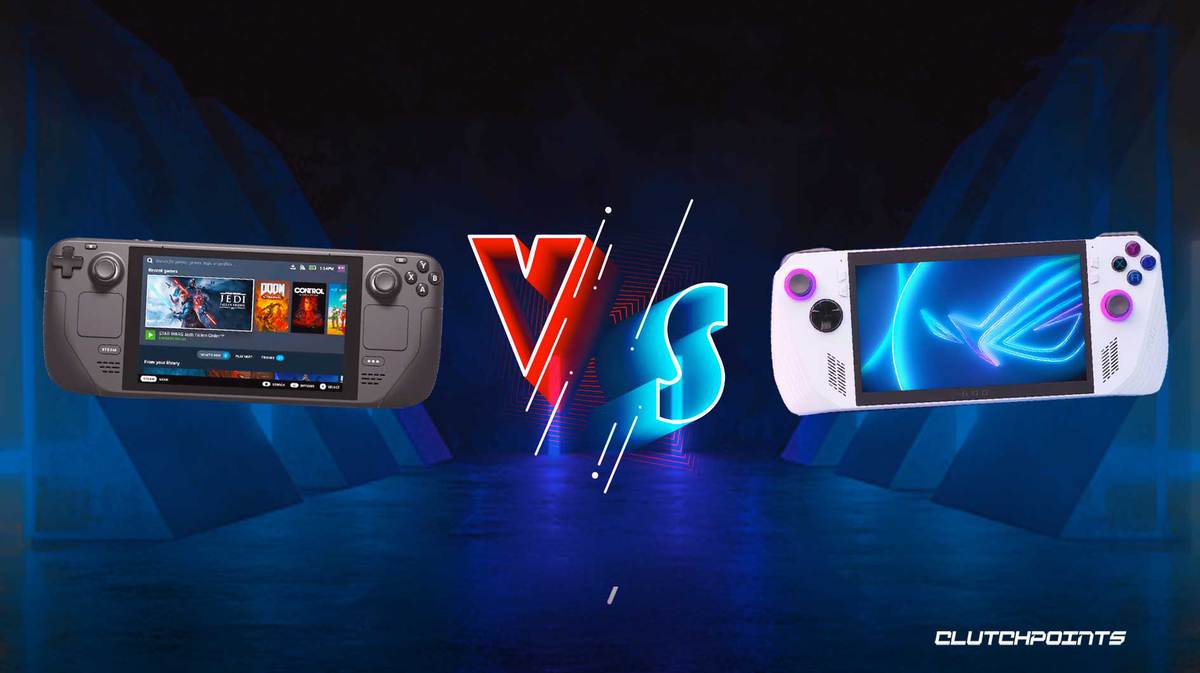Asus announced the ROG Ally on April Fools, revealing days later that they're serious about the product. Here's how the latest handheld PC gaming system compares to the Steam Deck.
ROG Ally vs. Steam Deck: A Comparison
A quick disclaimer: the new Asus product is currently just a prototype, and only two units exist today. These two units have been sent to two tech content creators: Dave2D and Linus. All the information available comes from their impressions and what Asus allows them to say, so we're pretty much limited when it comes to a full-on comparison. Asus may also make more changes to the prototype and have it different to some degree to the actual model shipped in the future. However, we do have enough information to have a general idea of how the ROG Ally fares against the Steam Deck.
ROG Ally Pros vs. Steam Deck:
- Ergonomic Design – Holding the new gaming handheld for the first time might give you discomfort, but playing the console propped against a surface will give you the best experience you could in such a setup.
- Lighter and Slimmer – The ROG Ally weighs exactly 589g, and is easier to carry arund than the Steam Deck as it is slimmer and lighter.
- Display – 1080p, 120Hz, with 500 nits of brightness, .7ms response time (all better than the Steam Deck) with a
- Performance – At 15 watts, 50% faster than the Steam Deck, at 35 watts, 100% faster than the Steam Deck, according to Asus
- Cooling Fans – With two cooling fans, it maintains low temperatures all the while keeping the noise down
- Speakers – ROG Ally has fantastic speakers with very high volume upper limits with good fideity
- Interface and Switcher Buttons – ROG Ally has more interface and switcher buttons, one of which switches between the game and windows, and another opens the ROG Armoury Crate
- System – Natively runs on Windows 11, which should natively support many games and launchers that an out-of-the-box Steam Deck couldn't
ROG Ally Cons vs. Steam Deck:
- Awkward Grasp – While the ROG Ally's current design makes it comfortable to play when propped on a surface, it's very uncomfortable to play while carrying it around, so don't expect it to be a bedside fixture
- System – The Steam Deck natively runs the SteamOS, which is a huge benefit for everyone who has massive Steam libraries
- Back Pedals – The Steam Deck has four back pedals, while the ROG Ally only has two
- Price – Rumors and speculations place the price range of the ROG Ally between $600 to as high as $700, although this hasn't been confirmed by any official source yet, as Asus claims that their handheld gaming PC will be “price competitive” to the Steam Deck
- IO – The ROG Ally requires the ROG XG Mobile Connector and doesn't have its dock, which is a very expensive alternative to it having its own dock (even if the ROG XG Mobile Connector is a powerful accessory). It also doesn't have a Thunderbolt or USB-4 input at all because of the RG XG Mobile Connector.
ROG Ally vs. Steam Deck Draws:
- Battery – Based on early impressions, it appears that both devices will have roughly the same battery life
- Driftless thumbsticks – Both devices also have thumbsticks that shouldn't be susceptible to drift
- Different Dpad Configurations – Both control schemes have good response time and tactile feedback, with the ROG Ally having a circular single Dpad while the Steam Deck uses a cross single Dpad
Tale of the Tape: ROG Ally vs. Steam Deck Specs Comparison
With recent leaks and news, we now know what the ROG Ally is packing exactly. See below the direct comparison of the technical specifications of the two rival handheld PCs:
| Specification | ROG Ally | Steam Deck |
| CPU | AMD Ryzen Z1 Series | Zen 2 4c/8t, 2.4-3.5GHz (up to 448 GFlops FP32) |
| Display | 7″ IPS Full 1080p HD 120Hz Display (500 nits 7ms) | 7″ IPS Full 720p 60Hz Display (400 nits) |
| GPU | RDNA 3 12 CUs | 8 RDNA 2 CUs, 1.0-1.6GHz (up to 1.6 TFlops FP32) |
| RAM | 16 GB LPDDR5 Dual Channel | 16 GB LPDDR5 on-board RAM (5500 MT/s quad 32-bit channels) |
| Storage | M.2-2230 512 GB PCIe Gen4 |
64 GB eMMC (PCIe Gen 2 x1) 256 GB NVMe SSD (PCIe Gen 3 x4 or PCIe Gen 3 x2*) 512 GB high-speed NVMe SSD (PCIe Gen 3 x4 or PCIe Gen 3 x2*) |
| Weight | 608 grams | 669 grams |
| Operating System | Windows 11 Built-in ROG Armoury Crate | Steam OS 3.0 Proton |
| Cooling | ROG Intelligent Cooling | Cooling Fans and Heat Sinks |
| Storage Expansion | UHS-II MicroSD Slot for expansion | UHS-II MicroSD Slot for expansion |
| Sound Device | Dolby Atmos | Stereo with embedded DSP for an immersive listening experience |
| SRP | Roughly $875 | 64GB: $399 256GB: $529 512GB: $649 |
So, what do you think? If you have neither yet, which one are you more leaning into now? If you already have a Steam Deck, will you stay with your old gear, or embrace the ROG Ally?




















